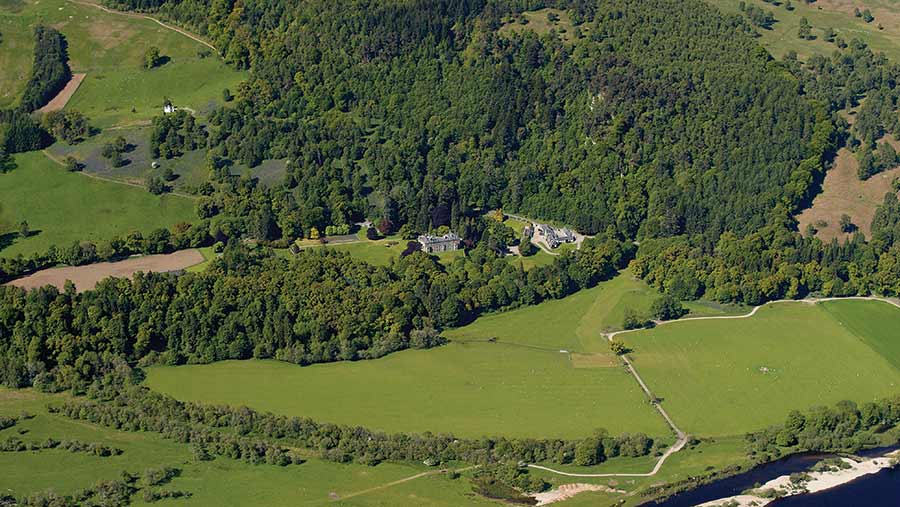Northern Scottish farmland market looks hopeful after subdued year
 The 6,000-acre Kinnaird Estate was launched for sale by Knight Frank and Bidwells in September at offers in excess of £9.6m. It has two mixed cropping and livestock farms, Balmacneil Farm (165 acres) and Balnamuir Farm (114 acres). © Aerial Photography Solutions
The 6,000-acre Kinnaird Estate was launched for sale by Knight Frank and Bidwells in September at offers in excess of £9.6m. It has two mixed cropping and livestock farms, Balmacneil Farm (165 acres) and Balnamuir Farm (114 acres). © Aerial Photography Solutions As part of our regional farmland outlook, this week we head to northern Scotland and the Highlands, where land agents predict a good number of sales will materialise next year.
This follows 12 months of steady prices, which have seen strong demand for rare offerings of good-quality arable land, but very few properties on the market in general.
Uncertainty, both in the political and farm business sense, during the past two years has led to some buyers holding off from purchases. But agents say greater clarity about BPS payments could lead more buyers to now enter the market.
See more: Regional outlook: Low farmgate prices will push more farms on to market in north of England
Arable units suited to contract-farming agreements have been favoured by investment buyers, but locals have also been active, as Farmers Weekly reports.
Land market values – North Scotland and Highlands |
||
| 12 months to September 2014 | 12 months to September 2015 | |
| No of farms publicly advertised nationally | 66 (16,181 acres)* | 106 (22,164 acres)** |
| Average value – all types of farmland | £4,600 | £4,600 |
| Average value – prime arable farmland | £7,900 | £7,900 |
| Average value – Grade 3 arable farmland | £5,800 | £5,800 |
| Average value – Grade 3 grassland | £3,000 | £3,000 |
|
* 12 months to December 2014. ** January to 21 November 2015. Source: Savills-SmithsGore. |
||
David Strang Steel, Strutt & Parker, Banchory
- Most farms have sold in lots rather than as a whole, so one could assume local buyers are active.
- I think there will be more farms for sale in 2016 than there were in 2015, due to a good harvest and the fact BPS entitlements are now in place. Perhaps some larger farms may come up for sale as people retire or downsize.
- Supply of land in 2015 has been very small, with very few commercial arable farms offered for sale, except around Dundee.
- The hardest farms to sell this year have been the very marginal stock farms. Meanwhile, farms close to towns or with amenity appeal have continued to attract viewers and offers. In the North East, the number of non-farmer buyers from the oil industry has fallen considerably.
- Looking back at 2015, it seems farmland values in Scotland peaked in spring 2015, due to farmgate prices, land reform issues and political uncertainty in Scotland for English buyers.
Crispian Cook, Bell Ingram, Inverness
- In the northern regions the reasons for sale have remained pretty solid – with retirements and consolidation of land from neighbouring farmers. Typically, buyers are coming from outside the area in search of land of the same quality they have sold elsewhere, but at a lower price.
- I think the market is going to remain largely the same in 2016, but questions remain over how buyers and sellers will react to entitlement transfer arrangements. Land with entitlements that are going to be transferred to the buyer is going to be preferable – something which was not an imperative in the past.
- High-quality land is in relatively short supply, and areas around the Moray coast, for example, will continue to be attractive.
- Grade 2 and Grade 3(1) is still in most demand. More marginal land and stock farms are proving harder to sell, especially to investors or farmers who want to set up contract-farming agreements because they are more complex on a stock unit than an arable operation.
Rod Christie, CKD Galbraith, Elgin
- There has been a steady supply in the region in comparison to recent years, and this has kept prices stable. Better-quality land is, as ever, most in demand, but buyers are carefully evaluating their options.
- Even marginal land is in demand, but it is finding its price level. For the right buyer, there is interest in it.
- Careful marketing and planning will be key this year for sellers. Understanding where your farm fits and where demand might be is still a very important consideration.
- There has been much uncertainty about the transfer of entitlements, but we have not seen that affecting sales so far.
